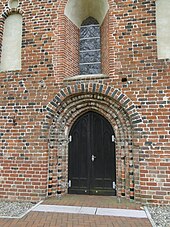Döbbersen village church
The Protestant village church Döbbersen is a late Romanesque-early Gothic brick church in the Döbbersen district of Wittendbod in the Ludwigslust-Parchim district in Mecklenburg-Western Pomerania . It belongs to the Döbbersen parish in the Parchim provost of the Evangelical Lutheran Church in Northern Germany (Northern Church) .
History and architecture
The church is a uniform structure, consecrated in 1255 under Westphalian influence, which consists of the retracted rectangular choir and the nave of two roughly square yokes, which is raised in the west as a tower and closed off with a squat pointed helmet. All components are provided with pilaster strips and serrated friezes. Only the paired windows on the north and south sides of the choir are closed with round arches, the other windows have truncated pointed arches. The east window is decorated with an inlaid round rod. The west wall of the church was rebuilt during the restoration in 1995.
Stepped portals with inlaid round bulges are arranged on the north side of the choir and the tower; the former has a blunt pointed arch, the latter a rounded arch. Both portals are decorated with glazed shaped stones . The room parts of the church are closed with dome-like groin vaults. The triumphal arch is also provided with a truncated pointed arch. Overall, the church can be classified as Romanesque, although its portals contain elements of brick Gothic.
Murals
Wall paintings from the 15th century show St. Gertrude on the northern triumphal arch ; St. George with the dragon is depicted on the south east wall of the nave . On the north wall, a mural from the second half of the 16th century shows Moses and Aaron next to the brazen serpent and opposite Luther and probably Melanchthon next to the cross. There are two rosettes in the nave vaults. The paintings were restored in 2006.
Furnishing
The main piece of equipment is a wooden altarpiece by Heinrich Johann Bülle from the years 1725 to 1729. It shows a Last Supper relief in the predella , a fully plastic crucifixion group in the main field, which is flanked by Moses and Aaron and a burial relief in the upper part. An octagonal granite baptism from the 13th century and a baroque baptism angel from 1704 complete the furnishings. In the tower yoke is a grave slab for Curt Pentz († 1620) with his relief representation framed by pilasters and round arches.
A bell was cast by Lorenz Strahlborn in Lübeck in 1743 and is tuned to the tone f sharp 1 +7.
organ
The organ is a work by Johann Heinrich Runge with originally six registers on a manual and pedal from 1878, which was expanded and restored in 2014 by Gottfried Schmidt from Rostock after a reconstruction in 1971. Today the slider chest instrument has 10 registers. The actions are mechanical.
|
|
||||||||||||||||||||||||||||||||||||
- Coupling : Man / P
literature
- Georg Dehio : Handbook of the German art monuments. Mecklenburg-Western Pomerania. 2nd Edition. Deutscher Kunstverlag, Berlin / Munich 2016, ISBN 978-3-422-03128-9 , p. 128.
Individual evidence
- ↑ Information on the village church Döbbersen on dorfkirchen-in-mv.de. Accessed January 31, 2018 .
- ↑ Information about the organ on the website of the Malchow Organ Museum. Retrieved September 3, 2017 .
Web links
- Literature about the village church Döbbersen in the state bibliography MV
- Website of the parish on nordkirche.de
Coordinates: 53 ° 34 ′ 45.6 " N , 11 ° 4 ′ 18.8" E


